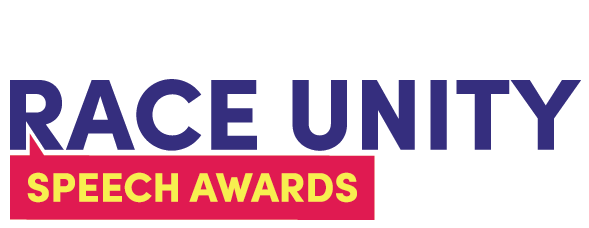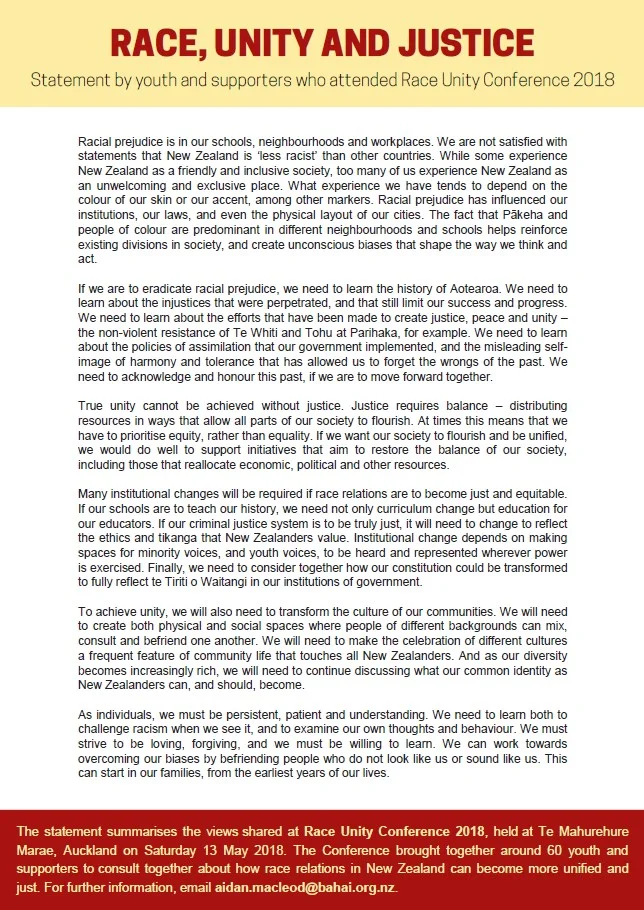Key documents
The following documents could be explored with a group or class of students, either as a precursor to participating in the Speech Awards or Hui or as a stand-alone learning activity.
2020 Speech Topic: Titiro Whakamuri, kia anga whakamua –
to face the future, look to the past
About this document
The questions and concepts in this document are the basis for the 2020 Race Unity Speech Awards and Hui. The focus is on reflecting on our past and building a shared vision of our future as a nation. The document includes four key questions, a whakatauāki and a quotation from the writings of the Bahá’í Faith. It also includes the requirements for entries in the Speech Awards.
Potential uses
Students participating in the Race Unity Speech Awards will need to study the speech topic, decide which of the four questions they want to address and select a suitable quotation to weave into their speech.
Most participants in the Speech Awards prepare individually, but group work could also be involved. For example, a whole class of students could discuss the questions in the speech topic, identifying a few shared views and themes. Then one or more students participating in the Speech Awards could draft their speech building on the views of the whole class.
Students can prepare to participate in the Race Unity Hui by discussing the questions in the speech topic. The sessions at the Hui will be based on many of the same concepts, and students may find it easier to share their views if they have considered them beforehand.
Students in media studies, drama or visual arts could create a video clip, skit or piece of art to explore one or more of the questions or quotations in the speech topic.
2019 discussion paper: Dismantling Institutional Racism in Aotearoa
About this document
Last August the 2019 Youth Statement on Race Relations was studied and discussed by over 40 influential New Zealanders, including MPs, government officials, academics and journalists. This paper is a synthesis of the views shared in those discussions, focused mainly on the issue of institutional racism. The paper not only describes the problem but sets out learning from current efforts to overcome institutional racism.
Potential uses
Teachers may benefit from studying the paper and reflecting on how institutional racism has affected their own experiences in the education system. This study could be carried out individually or as a group.
Senior social studies students may find the paper valuable for deepening their understanding of current discourse on race relations.
The paper and other documents on this website could be used in assessments where students describe or examine an example of social action.
2019 Youth Statement on Race Relations: Confronting Racism with Justice and Unity
About this document
The Youth Statement summarises and synthesises the views shared by over 150 young people who participated in the 2019 Race Unity Hui. Key themes include confronting racial prejudice, racism and equity in education, creating safe spaces to discuss race and culture, and dismantling institutional racism.
Potential uses
Students participating in the Speech Awards may find it useful to study this document to stimulate their thinking and get an idea of what is already being said about race, unity and justice.
Studying this document may also help students understand the purpose of the Race Unity Hui. Students may be motivated by understanding that their participation in the Hui may help shape a similar statement, and that last year’s statement had a real impact on the national conversation about race relations.
2019 Speech topic – Speaking for Justice, Working for Unity
About this document
This speech topic was the core content for the 2019 Speech Awards and Hui. This document is a great resource for starting a conversation about the concepts of race, unity, justice, polarisation and free speech. The sample slides give one example of how the speech topic could be explored in a classroom context. The speech topic includes questions for reflection and discussion, a whakataukī and a quote from the writings of the Baha’i Faith.
Potential uses
The questions and quotations in the speech topic could be used as the basis for speeches, essay exercises or other activities.
Students could discuss the questions in the speech topic as a whole class or in small groups.
Students in media studies, drama or visual arts could create a video clip, skit or piece of art to explore one or more of the questions or quotations in the speech topic.
2018 Conference Statement – Race, Unity and Justice
About this document
The 2018 National Race Unity Hui explored the relationship between race, unity and justice. The Conference Statement was prepared to reflect views shared by youth during small group discussions at the Hui. The document was shared with members of the media, government and civil society as an example of the sorts of views youth hold on race relations issues.
Potential uses
Students participating in the Speech Awards may find it useful to study this document to stimulate their thinking and get an idea of what is already being said about race, unity and justice.
Studying this document may also help students understand the purpose of the Race Unity Hui. Students may be motivated by understanding that their participation in a Hui may help shape a similar youth statement on race relations in 2020.
About this document
This is an online long-form news article published by Stuff.co.nz on the topic of ethnic diversity and racial prejudice in Auckland. It includes both video content and a written article. The article explores the experiences of a range of young New Zealanders living in Auckland and their concerns about racism.
Potential uses
This article could be studied by a class as a way of understanding others’ experiences of race and ethnic diversity.
The article could also be used as an entry point for a discussion of class members’ own experiences of race and ethnic diversity.
Media analysis techniques may also help students reflect critically and constructively on the article. For example, students could reflect on how the article and video are intended to affect the reader/viewer, and what film and writing techniques are used to achieve this.
‘Koia Mārika — So it is’, Tāmati Kruger, Bruce Jesson Memorial Lecture 2017
About this document
This is a lecture given by Tūhoe leader Tāmati Kruger in 2017. Tāmati was instrumental in a ground-breaking Treaty settlement that recognised Te Urewera as a legal entity not owned by any human being. The extract below may be a useful perspective on ‘race unity’ to explore with students.
Extract
So, here we are as a country, we’re kind of awkwardly fudging, searching, wanting to know who we are.
Some Tūhoe think that in the distant future, there may no longer be Europeans living in Aotearoa, because Europeans live in Europe. That, maybe, in a long distance, the only people you find in Aotearoa are tangata whenua, you and I tangata whenua — because we love the land equally. We have a commitment to it. We believe we are from the land, we will live with it, and we don’t really think that we need to own it.
So Tūhoe’s view is that one day, all of us in this room are going to be tangata whenua, and we’ll all sit down and talk about those Europeans in Europe, and how they’re mucking up the world, and they need our advice.
Maybe this difficult journey that Tūhoe is making, and that you will witness over the next 40 years, this difficulty that we will undergo, this pain that we will undergo, will produce a liberation for you, and for Aotearoa.
That we come to understand that culture and identity are just other words for what we share in common. That’s all it is, it’s just another word for that. And that is what we’re struggling with — understanding what it is we share in common.
And when we do not share in common, philosophy and ideology, and our kinship to each other and to this land — we dare not go into details like hokey pokey, and gumboots, singlets, football, and harbour bridges, or any kind of bridge would work. Maybe we should start thinking about these things. And let’s help each other reflect with that struggle and that disruption. And let’s not try and avoid it.
We kind of think that that might be a long view of our contribution to Aotearoa and to all New Zealanders.
Potential uses
Students participating in the Speech Awards or Hui may benefit from reading and discussing part of Tāmati’s lecture.
Some of the ideas in the lecture may be challenging or unfamiliar for students. Students may benefit from identifying elements of the text that they understand and don’t understand, and exploring the more difficult ideas in discussion with their teacher and peers.









